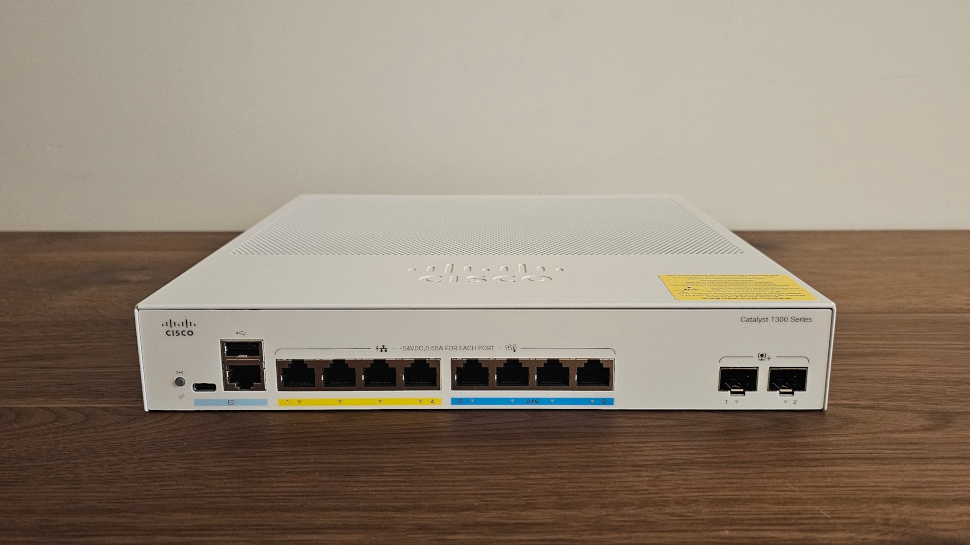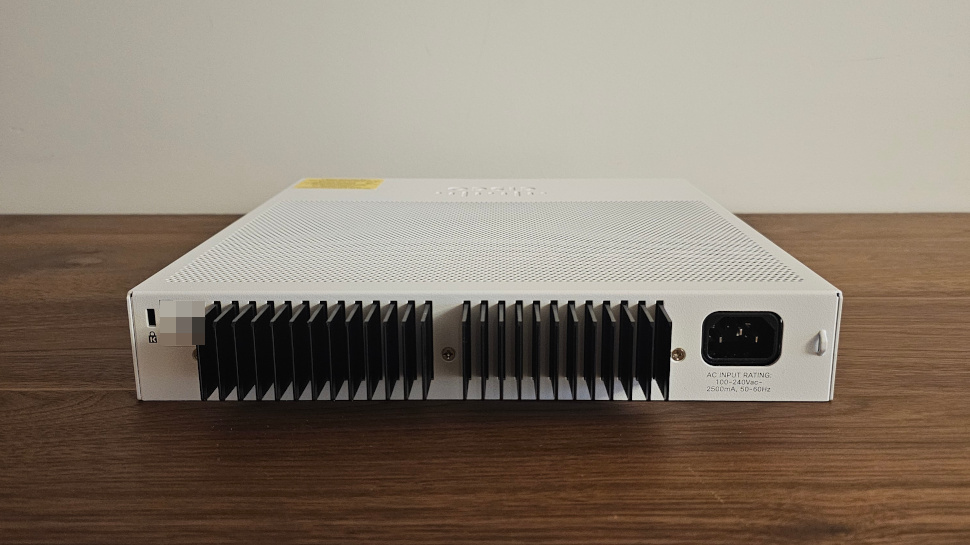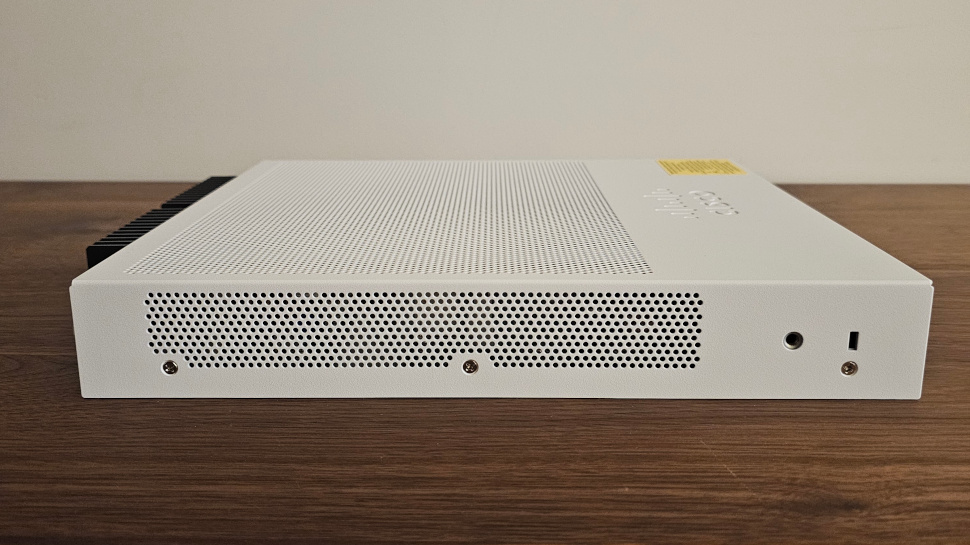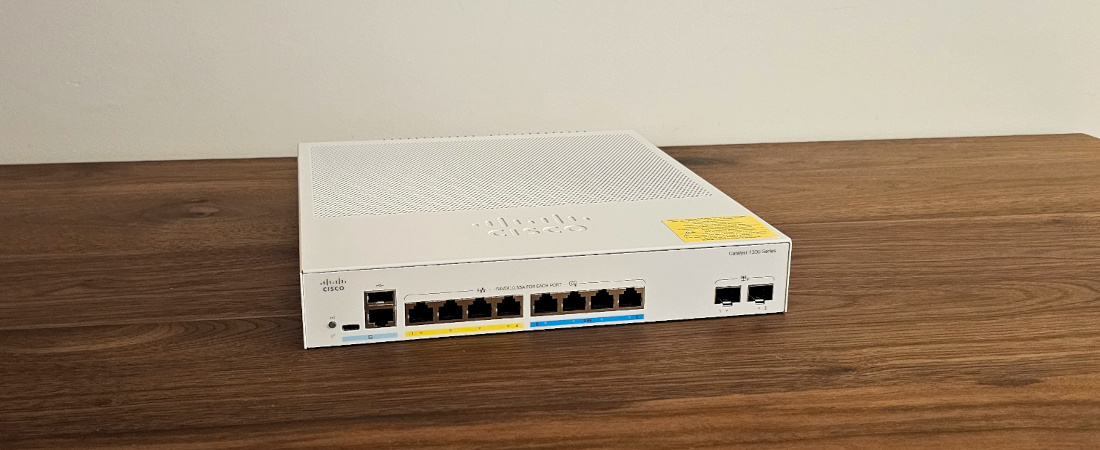TechRadar Verdict
The C1300-8MGP-2X enterprise switch brings 2.5Gb and SFP technologies to a home office with minimum fuss thanks to a well-designed mobile app. The passively cool unit offers a 120W PoE budget for surveillance cameras and Wi-Fi 7 access points.
Pros
- +
Passive cooling
- +
Uninterrupted PoE during firmware update
- +
Supports up to 10G through SFP+
- +
High packet processing capacity
Cons
- -
Price
- -
Single status LED per port
Why you can trust TechRadar
Cisco’s Catalyst C1300-8MGP-2X enterprise-class Ethernet switch manages small and medium-sized networks at speeds up to 10Gb.
CPU: Dual Core ARM 1.4GHz
RAM/Flash: 1GB/512MB
Ports: Four 1Gb, Four 2.5Gb
PoE budget: 30W per port, a total of 120W
Processing throughput: 41.66 Million packets per second
Dimensions/Weight: 26.8 cm x 32.3 cm x 4.4 cm/2.64 kg
It has eight wired interfaces, a 120W PoE, and two 10G SFP sockets. The compact fan-less unit consumes 20W when idle. As with all Cisco switches, a PC interface is available on the front panel to speed up installation through a Type-C USB socket, providing backup for the switch settings.
The Catalyst 1300 series uses a customized Linux OS and sports a dual-core network CPU, enabling an intuitive dashboard and fast packet processing with lower network latency. The high-end hardware simplifies network setup and provides security, and QOS features out-of-the-box. Cisco networking appliances integrate seamlessly with other devices, such as access points, through their cloud platform.
Is it the best network switch for your needs, though? Read on...
C1300-8MGP-2X: Price and availability
The Cisco C1300-8MGP-2X is available on Amazon for $718 and has a lifetime warranty. The eight-port unit supports 1Gb, 2.5Gb copper Ethernet, and 10Gb through SFP modules.

C1300-8MGP-2X: Design
The C1300-8MGP-2X is a compact unit measuring 26.8 cm x 32.3 cm x 4.4 cm and weighing 2.64 kg. As with other models in the C1300 series, all network and debugging ports are on the front. The back has two large heatsinks with no fan, which makes the switch ideal for an office where minimum noise is essential. Each side of the white enclosure has one screw hole for rack-mounting.
The front panel hosts eight RJ45 connectors, divided into two bandwidth groups. Four 1Gb Ethernet ports on the left provide around 30W each for PoE purposes to connected devices. The right offers a similar arrangement but with 2.5Gb Ethernet ports. The copper ports have a total PoE power budget of 120W. Two SFP slots support up to 10G modules and complete the list of interfaces.
Sign up to the TechRadar Pro newsletter to get all the top news, opinion, features and guidance your business needs to succeed!
Copper ports display their status on individual LEDs. The one LED per port approach differs from the previous model, which used two LEDs showing port activity and PoE warnings. As a result, the C1300 LEDs are more challenging to understand during troubleshooting. A reset button helps to restore factory settings should the switch become inaccessible.
Under the hood, the C1300 uses a Marvell dual-core 1.4GHz ARM processor, 1GB of RAM, and 512MB for application storage. The processor connects to two network ASICs that route packets at a maximum throughput of 10Gb per second to the eight copper ports and two SFPs. The processor can do packet analysis on the fly, significantly reducing latency while making the network more reactive to sudden changes.

C1300-8MGP-2X: In Use
The switch boots in less than two minutes. The system LED on the left shows progress and blinks green during the boot process, eventually settling on a solid green if all goes well. For each port, a single LED shows activity but not link-up speed. PoE is available as Ethernet becomes ready across the ports. Unlike older models, the SFP connectors do not share resources with any copper ports; using SFP will not turn off any copper port.
The C1300-8MGP-2X includes several new features compared to its predecessor. Bluetooth support is through a USB dongle, allowing remote and secure wireless access to the CLI and GUI. The PoE is undisturbed during reboots, allowing connected devices to retain power. Finally, a built-in REST API makes automation possible.
With an aggregated bandwidth of 56Gbps, the C1300-8MGP-2X should be enough for speedier 2.5G and 10G network appliances such as a NAS or a VPN. The processor can forward up to 42 million packets per second, thus maintaining minimum network lag. Moreover, the PoE budget of 120W makes connecting several outdoor devices, such as high-resolution cameras, a breeze. The unit consumes 20W idle with one 2.5G copper and one SFP connection.
The C1300 requires registration to be accessible from the Internet. For this, the Cisco Business mobile app initiates the installation using a QR code at the back of the case. The app offers most features available on the cloud, with many configurations done in less than four steps. The switch processes packets on Layer 2 and 3, providing security through VLANs or blocking unknown IPs.

C1300-8MGP-2X: The competition
The Engenius ECS2510FP targets a similar audience as the C1300-8MGP-2X switch. Its eight 2.5Gbps ports and double PoE power budget make it a serious contender, priced at less than $500. However, the ECS2510FP has two fans, which makes it impossible to use on a desk. The power consumption is also higher than the eight ports in the C1300 series, making it more costly in the long run.
C1300-8MGP-2X: Final verdict
With the new Catalyst C1300-8MGP-2X switch, Cisco improves on a tried and trusted platform, adding more security and practical features that make setup and configuration easier. The SOHO-type switch with a dual-core CPU is well equipped to fully utilize the quad 10 Gb and quad 2.5 Gb Ethernet ports. The companion mobile app is responsive and implements most of the functionality found on the cloud. Being passive, power consumption and noise are minimal, making the unit ideal in a small office.
The main drawbacks are the higher MSRP compared to similar units available elsewhere and the ports' status shown on a single LED.
you need a reliable switch with PoE and supporting 10G Ethernet.
you are on a tight budget.
We've listed the best mesh Wi-Fi systems.
Brian has over 30 years publishing experience as a writer and editor across a range of computing, technology, and marketing titles. He has been interviewed multiple times for the BBC and been a speaker at international conferences. His specialty on techradar is Software as a Service (SaaS) applications, covering everything from office suites to IT service tools. He is also a science fiction and fantasy author, published as Brian G Turner.

